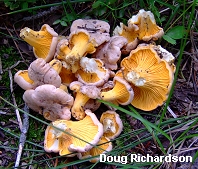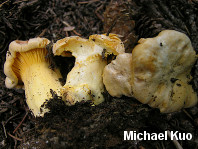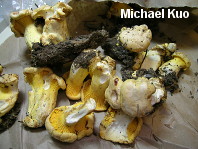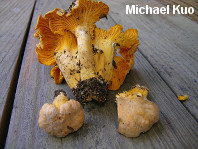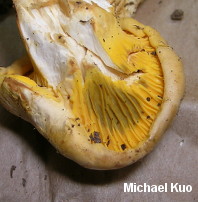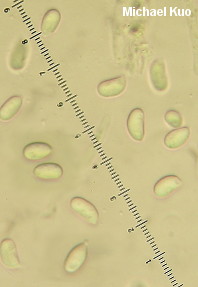| Major Groups > Chanterelles and Trumpets > Cantharellus roseocanus |

|
Cantharellus roseocanus [ Basidiomycota > Cantharellales > Cantharellaceae > Cantharellus . . . ] by Michael Kuo Cantharellus roseocanus was originally described by Redhead and collaborators (1997) as a variety of Cantharellus cibarius from the Pacific Northwest, where it grows under sitka spruce, shore pine, or Engelmann spruce. Distinguishing features for this gorgeous chanterelle include the stunningly bright orange false gills, which contrast markedly with the duller cap surface; and the pinkish bloom that often covers young caps. Since it was originally described, however, the range of Cantharellus roseocanus has been expanded to include the Rocky Mountains, and northern Midwestern and eastern North American jack pine forests. In 2013 a paper by Foltz and collaborators finally published peer-reviewed data allowing us to promote roseocanus from variety to species. Description: Ecology: Mycorrhizal with spruces (including sitka spruce and Engelmann spruce) and with two-needled pines (including Bishop pine, lodgepole pine, and jack pine); growing alone, gregariously or in loose clusters; summer and fall; distributed from the Rocky Mountains westward, and reported from Québec to Maine. The illustrated and described collections are from Colorado and Wyoming. Cap: 2.5-10 cm across; more or less planoconvex when young (often with a rolled-under margin); becoming flat or shallowly depressed, with a wavy and irregular margin; tacky when wet; pale yellow to egg-yolk yellow or orange; often fading to nearly whitish when exposed to sunlight; when young with a pale to dark pink bloom, especially near the margin; not bruising when handled, or bruising brownish very slowly. Undersurface: With well developed false gills that frequently feature cross-veins; running deeply down the stem; bright, intense orange (usually contrasting markedly with the cap surface); not bruising, or bruising slowly brownish. Stem: 2-5 cm long; 1-2 cm thick; variable in shape but often stocky; bald; dry; colored like the cap, or colored like the undersurface; not bruising, or bruising slowly brownish. Flesh: Whitish; solid; unchanging when sliced. Odor and Taste: Taste not distinctive, or slightly peppery; odor fragrant and sweet, like apricots. Chemical Reactions: Iron salts olive to olive gray on undersurface. Spore Print: Pale orange-yellow.Microscopic Features: Spores 7-10 x 4-5 µ; ellipsoid; smooth; inamyloid; faintly ochraceous in KOH; contents minutely granular. Basidia 4-6-sterigmate; 60-95 µ long. Elements from cap surface 5-10 µ wide; cylindric; septate; clamped; thin-walled; hyaline in KOH; terminal cells cylindric with rounded apices, or occasionally subclavate. REFERENCES: (Redhead, Norvell & Danell, 1997) Redhead, Norvell & Moncalvo, 2012. (States, 1990; Pilz et al., 2003; Trudell & Ammirati, 2009; Buyck & Hofstetter, 2011; Rochon et al., 2011; Foltz et al., 2013.) Herb. Kuo 08140701, 08170804; DBG RMNP 2008-182, 2008-183. This site contains no information about the edibility or toxicity of mushrooms. |
© MushroomExpert.Com |
|
Cite this page as: Kuo, M. (2015, February). Cantharellus roseocanus. Retrieved from the MushroomExpert.Com Web site: http://www.mushroomexpert.com/cantharellus_roseocanus.html |
